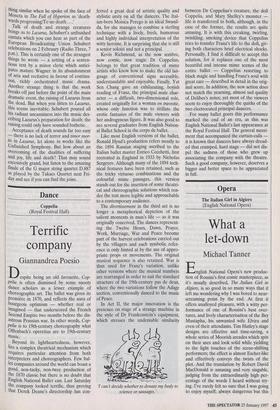Dance
Cuppelia (Royal Festival Hall)
Terrific company
Giannandrea Poesio
Despite being an old favourite, Cop- pelia is often dismissed by some snooty dance scholars as a lesser example of choreographic art. The ballet was given its premiere in 1870, and reflects the aura of bourgeois optimism — whether real or imagined — that underscored the French Second Empire two months before the dis- astrous Prussian war. In other words, Cop- Pella is to 19th-century choreography what Offenbach's operettas are to 19th-century music.
Beyond its lightheartedness, however, lies a complex theatrical mechanism which requires particular attention from both interpreters and choreographers. Few bal- let companies around the world can boast a good, non-tacky, non-twee production of the 1870 classic but there is no doubt that English National Ballet can. Last Saturday the company looked terrific, thus proving that Derek Deane's directorship has con- ferred a great deal of artistic quality and stylistic unity on all the dancers. The Ital- ian-born Monica Perego is an ideal Swanil- da, for she manages to combine a sterling technique with a lively, fresh, humorous and highly individual interpretation of the witty heroine. It is surprising that she is still a senior soloist and not a principal.
Kevin Richmond, as the now sombre, now comic, now tragic Dr Coppelius, belongs to that great tradition of mime artists who know how to make the old lan- guage of conventional signs accessible, understandable and enjoyable. Finally, Yat Sen Chang gave an exhilarating, boyish reading of Franz, the principal male char- acter — a difficult, two-dimensional role, created originally for a woman en travestie, whose only function was to titillate the erotic fantasies of the male viewers with her androgynous figure. It was also good to see several graduates from English Nation- al Ballet School in the corps de ballet.
Like most English versions of the ballet, Ronald Hynd's production refers mostly to the 1894 Russian staging ascribed to the Italian ballet master Enrico Cecchetti, first recreated in England in 1933 by Nicholas Sergeyev. Although many of the 1894 tech- nical features have been retained, such as the tricky virtuoso combinations and the colourful mime passages, this version stands out for the insertion of some theatri- cal and choreographic solutions which ren- der the text more legible and approachable to a contemporary audience.
The divertissement in the third act is no longer a metaphorical depiction of the salient moments in man's life — as it was originally conceived. The dances represent- ing the Twelve Hours, Dawn, Prayer, Work, Marriage, War and Peace become part of the harvest celebrations carried out by the villagers and each symbolic refer- ence is only hinted at by the use of appro- priate props or movements. The original musical sequence is also retained. War is thus used for Franz's variation, unlike other versions where the musical numbers are rearranged in order to suit the standard structure of the 19th-century pas de deux, where the two variations follow the Adage section, conventionally danced to the music of Peace.
In Act II, the major innovation is the presence on stage of a strange machine in the style of Dr Frankenstein's equipment, which stresses the undeniable similarity I can't decide whether to donate my body to science or sausages.' between Dr Coppelius's creature, the doll Coppelia, and Mary Shelley's monster life is transferred to both, although, in the case of the former, the results are quite amusing. It is with this creaking, twirling, twinkling, smoking device that Coppelius tries to transfer Franz's life to the doll, giv- ing both characters brief electrical shocks. Personally, I find it difficult to accept this solution, for it replaces one of the most beautiful and intense mime scenes of the entire ballet — Coppelius resorting to black magic and handling Franz's soul with great care — described in detail in the orig- inal score. In addition, the new action does not match the yearning, almost sad quality of Delibes's notes; yet most of the viewers seem to enjoy thoroughly the quirks of the two electrocuted principal dancers.
For many ballet goers this performance marked the end of an era, as this was English National Ballet's last appearance at the Royal Festival Hall. The general merri- ment that accompanied the curtain-calls it is known that dancers have always dread- ed that cramped, hard stage — did not dis- pel the sadness of those who grew up associating the company with the theatre. Such a good company, however, deserves a bigger and better space to be appreciated in full.


































































 Previous page
Previous page